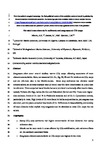Elevated trace elements in sediments and seagrasses at CO2 seeps
| dc.contributor.author | Mishra, AK | |
| dc.contributor.author | Santos, R | |
| dc.contributor.author | Hall -Spencer, JM | |
| dc.date.accessioned | 2019-12-26T16:24:36Z | |
| dc.date.issued | 2020-01 | |
| dc.identifier.issn | 0141-1136 | |
| dc.identifier.issn | 1879-0291 | |
| dc.identifier.other | 104810 | |
| dc.identifier.uri | http://hdl.handle.net/10026.1/15273 | |
| dc.description.abstract |
Seagrasses often occur around shallow marine CO2 seeps, allowing assessment of trace metal accumulation. Here, we measured Cd, Cu, Hg, Ni, Pb and Zn levels at six CO2 seeps and six reference sites in the Mediterranean. Some seep sediments had elevated metal concentrations; an extreme example was Cd which was 43x more concentrated at a seep site than its corresponding reference site. Three seeps had metal levels that were predicted to adversely affect marine biota, namely Vulcano (for Hg), Ischia (for Cu) and Paleochori (for Cd and Ni). There were higher-than-sediment levels of Zn and Ni in Posidonia oceanica and of Zn in Cymodocea nodosa, particularly in roots. High levels of Cu were found in Ischia seep sediments, yet seagrass was abundant there, and the plants contained low levels of Cu. Differences in bioavailability and toxicity of trace elements helps explain why seagrasses can be abundant at some CO2 seeps but not at others. | |
| dc.format.extent | 104810-104810 | |
| dc.format.medium | Print-Electronic | |
| dc.language | en | |
| dc.language.iso | en | |
| dc.publisher | Elsevier BV | |
| dc.subject | Bioaccumulation | |
| dc.subject | Bioavailability | |
| dc.subject | Ocean acidification | |
| dc.subject | Posidonia oceanica | |
| dc.subject | Cymodocea nodosa | |
| dc.title | Elevated trace elements in sediments and seagrasses at CO2 seeps | |
| dc.type | journal-article | |
| dc.type | Journal Article | |
| plymouth.author-url | https://www.webofscience.com/api/gateway?GWVersion=2&SrcApp=PARTNER_APP&SrcAuth=LinksAMR&KeyUT=WOS:000508769700013&DestLinkType=FullRecord&DestApp=ALL_WOS&UsrCustomerID=11bb513d99f797142bcfeffcc58ea008 | |
| plymouth.volume | 153 | |
| plymouth.publication-status | Published | |
| plymouth.journal | Marine Environmental Research | |
| dc.identifier.doi | 10.1016/j.marenvres.2019.104810 | |
| plymouth.organisational-group | /Plymouth | |
| plymouth.organisational-group | /Plymouth/Faculty of Science and Engineering | |
| plymouth.organisational-group | /Plymouth/Faculty of Science and Engineering/School of Biological and Marine Sciences | |
| plymouth.organisational-group | /Plymouth/PRIMaRE Publications | |
| plymouth.organisational-group | /Plymouth/REF 2021 Researchers by UoA | |
| plymouth.organisational-group | /Plymouth/REF 2021 Researchers by UoA/UoA07 Earth Systems and Environmental Sciences | |
| plymouth.organisational-group | /Plymouth/Research Groups | |
| plymouth.organisational-group | /Plymouth/Research Groups/Marine Institute | |
| plymouth.organisational-group | /Plymouth/Users by role | |
| plymouth.organisational-group | /Plymouth/Users by role/Academics | |
| dc.publisher.place | England | |
| dcterms.dateAccepted | 2019-10-04 | |
| dc.rights.embargodate | 2020-10-7 | |
| dc.identifier.eissn | 1879-0291 | |
| dc.rights.embargoperiod | Not known | |
| rioxxterms.versionofrecord | 10.1016/j.marenvres.2019.104810 | |
| rioxxterms.licenseref.uri | http://www.rioxx.net/licenses/all-rights-reserved | |
| rioxxterms.type | Journal Article/Review |


